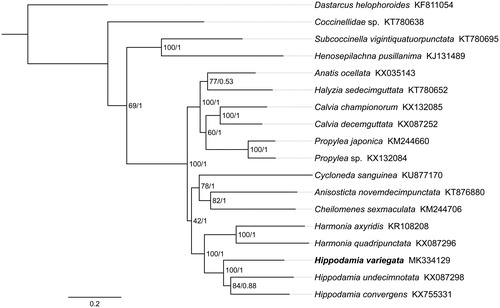Abstract
Hippodamia variegata is an important predator of aphid pests. In this study, we determined the complete mitochondrial genome (mitogenome) of H. variegata. The mitogenome is 17,823 bp in length, consisting of 13 protein-coding genes (PCGs), 22 transfer RNA (tRNA) genes, two ribosomal RNA (rRNA) genes, and one non-coding control region. Initiation codons ATA, ATG, ATT, and AAT were identified in two, five, five, and one PCGs, respectively, whereas stop codons TAA or TAG were found in eight genes except for five genes which use incomplete stop codon T–. The phylogenetic analysis indicated that three species in Hippodamia (H. variegata, H. convergens, and H. undecimnotata) were closely related and had a close relationship with the genus Harmonia.
Hippodamia variegata, an important aphidophagous predator, is widely distributed in Palearctic region (Obrycki and Orr Citation1990; Farhadi et al. Citation2011). It is important natural enemy of aphids infesting crops, weeds, and ornamental plants (Franzmann Citation2002; Kontodimas and Stathas Citation2005). Mitochondrial DNA has many characteristics, for instance, simple genetic structure, maternal inheritance, and relatively high evolutionary rate, which make it highly useful in studies of molecular evolution, phylogenetics and population genetics (Abascal et al. Citation2006; Cameron Citation2014).
Specimens of H. variegata were collected from Yuzhong County, Gansu Province, China (35°34′N, 103°49′E) in June 2018 and stored in Insect Collection of Gansu Agricultural University (Accession number GAU-HIPVA180601). Genomic DNA was extracted from muscle tissues using DNeasy DNA Extraction kit (Qiagen). Mitochondrial genome sequence was generated using Illumina HiSeq 2500 Sequencing System. In total, 5.9 G raw reads were obtained, quality-trimmed, and assembled using MITObim v 1.7 (Hahn et al. Citation2013). The genome was annotated using software GENEIOUS R8 (Biomatters Ltd., Auckland, New Zealand).
The complete mitochondrial genome of H. variegata (Genbank accession, MK334129) is 17,823 bp in length and contains 13 protein-coding genes (PCGs), 22 tRNA genes, two rRNA genes, and one non-coding AT-rich region. The gene order is highly conserved and identical to Hippodamia convergens (KX755331). Most mitochondrial genes are encoded on the majority strand except for four PCGs, two rRNA genes and eight tRNA genes. The overall base composition is A (39.9%), T (37.6%), C (13.3%), and G (9.2%), with an AT content of 77.5%, which is consistent with most mitochondrial genomes. All PCGs of H. variegata have the conventional start codon for invertebrate mitochondrial PCGs (ATN), with the exception of cox1 which begin with AAT, as the asparagine (AAT or AAC) are proposed to be the start codon for cox1 in suborder Polyphaga (Sheffield et al. Citation2008). Most of the PCGs terminate with the stop codon TAA or TAG, whereas cox1, cox2, atp6, cox3, and nad6 end with the incomplete codon T. Two rRNA genes (rrnL and rrnS) locate at trnL1/trnV and trnV/control regions, respectively, and both rRNA genes are encoded on the minority strand. The 22 tRNA genes range from 55 bp (trnS1) to 70 bp (trnK). The length of control region is 1590 bp, with the AT content of this region is up to 79.8%.
To validate the phylogenetic position of H. variegata, 13 mitochondrial protein-coding genes sequences were extracted from the complete mitochondrial DNA sequences of 17 closely related taxa of Coccinellidae, including one outgroup species from Bothrideridae. Each of the 13 PCGs was aligned separately, then the phylogenetic tree was constructed using the maximum-likelihood method through raxmlGUI 1.5 (Silvestro and Michalak Citation2012) and the Bayesian inference method through MrBayes 3.2.6 (Ronquist and Huelsenbeck Citation2003). Results showed that three Hippodamia species get together to one clade and has a close relationship with the genus Harmonia (). In conclusion, the complete mtDNA of H. variegata is decoded in this study and provides essential and important DNA molecular data for further phylogenetic and evolutionary analysis for Coccinellidae.
Acknowledgements
We are grateful for the assistance of all staff and students in the Biocontrol Engineering Laboratory of Crop Diseases and Pests of Gansu Province, College of Plant Protection, Gansu Agricultural University, Lanzhou, China.
Disclosure statement
The authors report no conflict of interest. The authors alone are responsible for the content and writing of the article.
Additional information
Funding
References
- Abascal F, Posada D, Knight RD, Zardoya R. 2006. Parallel evolution of the genetic code in arthropod mitochondrial genomes. PLoS Biol. 4:e127.
- Cameron SL. 2014. Insect mitochondrial genomics: implications for evolution and phylogeny. Annu Rev Entomol. 59:95–117.
- Farhadi R, Allahyari H, Chi H. 2011. Life table and predation capacity of Hippodamia variegata (Coleoptera: Coccinellidae) feeding on Aphis fabae (Hemiptera: Aphididae). Biol Control. 59:83–89.
- Franzmann BA. 2002. Hippodamia variegata (Goeze) (Coleoptera: Coccinellidae), a predacious ladybird new in Australia. Aust J Entomol. 41:375–377.
- Hahn C, Bachmann L, Chevreux B. 2013. Reconstructing mitochondrial genomes directly from genomic next-generation sequencing reads-a baiting and iterative mapping approach. Nucleic Acids Res. 41:e129.
- Kontodimas DC, Stathas GJ. 2005. Phenology, fecundity and life table parameters of the predator Hippodamia variegata reared on Dysaphis crataegi. Biocontrol. 50:223–233.
- Obrycki JJ, Orr CJ. 1990. Suitability of three prey species for Nearctic populations of Coccinella septempunctata, Hippodamia variegata, and Propylea quatuordecimpunctata (Coleoptera: Coccinellidae). J Econ Entomol. 83:1292–1297.
- Ronquist F, Huelsenbeck JP. 2003. MrBayes 3: Bayesian phylogenetic inference under mixed models. Bioinformatics. 19:1572–1574.
- Sheffield N, Song H, Cameron S, Whiting M. 2008. A comparative analysis of mitochondrial genomes in Coleoptera (Arthropoda: Insecta) and genome descriptions of six new beetles. Mol Biol Evol. 25:2499–2509.
- Silvestro D, Michalak I. 2012. RaxmlGUI: a graphical front-end for RAxML. Org Divers Evol. 12:335–337.

